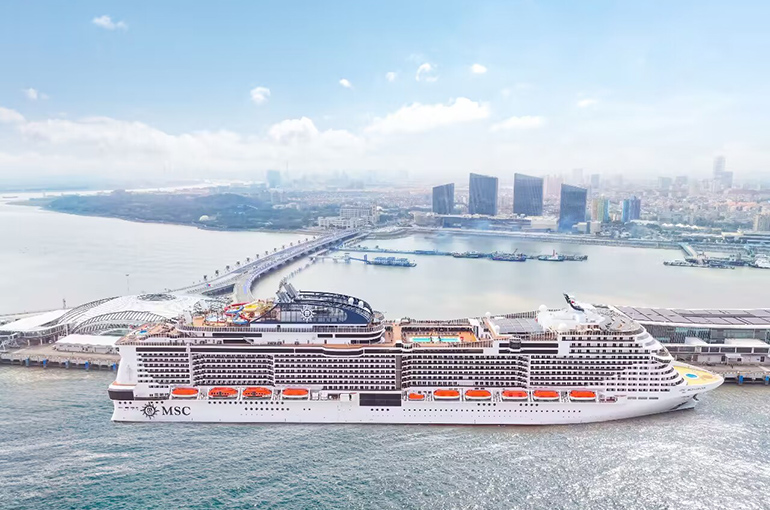 MSC Returns to Chinese Mainland With Largest Cruise Line Flagship in Asia
MSC Returns to Chinese Mainland With Largest Cruise Line Flagship in Asia(Yicai) March 18 -- The largest flagship cruise liner in Asia, the MSC Bellissima owned by Switzerland’s MSC Cruises, embarked from Shanghai two days ago after becoming the first international cruise ship to return to the Chinese mainland since the Covid-19 pandemic.
The 172,000-ton ship’s maiden voyage from Shanghai fulfils a promise MSC Cruises made to the Chinese market five years ago, which was also the Geneva-based firm’s best year, Chief Executive Gianni Onorato said.
MSC Cruises’ commitment to China remains as strong as ever, Onorato said, adding that the Asian country continues to play an important strategic role for the company.
The MSC Bellissima has more than 2,217 cabins and can accommodate 5,686 guests. This season, it will operate 25 itineraries from Shanghai and Shenzhen to popular destinations such as South Korea’s Jeju Island and the Japanese city of Kagoshima. Another vessel, the MSC Splendida, will voyage from Shenzhen and Xiamen home ports from this December through to April next year.
The consumption habits of Chinese tourists have changed compared with before the pandemic, according to Huang Ruiling, president of MSC Cruises China. For example, they tend to book early rather than waiting until the last minute, and their demand for quality travel has increased, with Deluxe Balcony, Premium and MSC Yacht Club cabins more popular than interior cabins. More young tourists are also choosing to go on cruises, he said.
MSC Bellissima has made some changes accordingly, such as offering cuisine that suits Chinese tastes, lively and varied onboard entertainment, including shows, music, and kids activities, as well as healthcare services to improve customer satisfaction.
MSC Cruises has also been using various Chinese social media platforms, such as WeChat’s Channels and Xiaohongshu, for account operations, content creation, promotions, and interaction, with regular activities such as livestreaming.
“This helps us effectively communicate our offerings to consumers and trade partners, leveraging the power of digital marketing to showcase the unique experience MSC Cruises provides,” Huang told Yicai.
“All of these efforts demonstrate our commitment to promoting the high-quality development of the Chinese cruise economy,” Onorato said. “We’re committed to further investing in China, enhancing the local economy by increasing global and local procurement, particularly in areas like new ship construction and dining, as well as hiring more Chinese crew members.”
More Choice
The Adora Magic City, the first big cruise ship built in China and operated by Asian cruise line Adora Cruises, a joint venture of China State Shipbuilding and American cruise company Carnival, completed its maiden voyage earlier this year. Onorato said that with Adora Cruises in the market, travellers now have a wider range of choice, which is always a good thing.
There are good examples around the world where domestic cruise lines operate alongside international competitors, offering people better choices and different experiences based on their preferences, Onorato said.
On the subject of profitability, Onorato said the Chinese market can be as lucrative as any other, as ticket prices have increased by double-digits. “As a privately held, family-owned company focused on long-term success rather than stock market performance, we're confident in China's profitability,” he said.
MSC Cruises have been expanding its fleet without resorting to borrowing, said Onorato, with five new ships delivered and two more on order, demonstrating the firm’s commitment to the cruise market in China and worldwide.
Market Turnaround
With Adora Cruises, MSC Cruises, and the imminent return of Royal Caribbean Cruises next month, the Chinese market is returning to growth, Zheng Weihang, vice president of the cruise and yacht branch of the China Transportation Association, told Yicai.
There are now more local and international cruises, ranging from short trips of less than 10 days and longer voyages of around 15 days. The Chinese cruise sector has transformed from just tourism into a complete industry chain encompassing manufacturing, operation, and port services.
For example, China now has 12 cruise ship ports and 14 in the works and has began to establish its place in the sector’s catering and hotel supply chains.
In China this year, the sector is expected to recover to 70 percent of what it was in 2019, be in full recovery next year, and enter a golden decade from 2026, according to Zheng.
Editor: Tom Litting